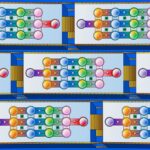Deep reinforcement learning (DRL) has emerged as a powerful paradigm for training robots to perform complex tasks. This article explores advanced techniques within DRL that are pushing the boundaries of robotic capabilities. We will delve into crucial areas including hierarchical reinforcement learning, which allows for breaking down complex tasks into smaller, more manageable subtasks. We will then examine transfer learning, a technique enabling robots to leverage knowledge gained from previous tasks to accelerate learning in new environments. Furthermore, we’ll discuss the use of imitation learning, where robots learn from expert demonstrations, and finally, we will explore the challenges and future directions of applying these advanced DRL methods in real-world robotics. This exploration will provide a comprehensive overview of the state-of-the-art in DRL for robotics, highlighting both the advancements and the ongoing challenges in this rapidly evolving field.
Hierarchical Reinforcement Learning
Traditional reinforcement learning methods often struggle with the complexity of real-world robotic tasks. Hierarchical reinforcement learning (HRL) addresses this by decomposing a complex task into a hierarchy of simpler subtasks. This approach allows agents to learn high-level policies that manage the overall task progress, and low-level policies that execute specific actions. For example, in a robotic manipulation task, the high-level policy might decide to grasp an object, while the low-level policy handles the precise finger movements. This modularity simplifies the learning process, improves sample efficiency, and facilitates the transfer of knowledge between different tasks. One key advantage is that the agent can learn reusable skills, avoiding repetitive learning for similar subtasks across different main tasks. Effective HRL algorithms often employ options or temporal abstractions, creating a structured policy representation that leverages both temporally extended actions and simpler sub-goals. The design and selection of appropriate hierarchies remains an area of active research, with various methods being explored to automatically discover optimal task decompositions.
Transfer Learning
Training a robot from scratch for each new task is computationally expensive and time-consuming. Transfer learning aims to mitigate this by enabling robots to leverage knowledge acquired from previously learned tasks to accelerate learning in new, related tasks. This can involve transferring learned policies, parameters of neural networks, or even feature representations. Domain adaptation techniques are often used to bridge the gap between source and target domains, accounting for differences in the environment, sensors, or task specifications. For instance, a robot trained to pick and place objects in a simulated environment can transfer its learned policy to a real-world scenario, significantly reducing the training time required in the real world. Effective transfer learning in robotics requires careful consideration of task similarity and domain adaptation strategies. The selection of appropriate features to transfer and the design of suitable architectures are also crucial factors impacting the success of transfer learning.
Imitation Learning
Imitation learning offers a powerful alternative to traditional reinforcement learning, particularly when reward functions are difficult to design or when sufficient data from expert demonstrations is available. In this approach, robots learn by observing and imitating expert behavior, often using techniques such as behavioral cloning or inverse reinforcement learning. Behavioral cloning directly maps observations to actions based on expert demonstrations, while inverse reinforcement learning aims to infer the reward function that motivated the expert’s behavior. Imitation learning can greatly reduce the amount of trial-and-error learning needed, leading to faster training and improved sample efficiency. However, challenges remain in handling noisy or incomplete demonstrations, and mitigating the problem of compounding errors in behavioral cloning. Advancements in this area focus on robust imitation learning methods capable of handling real-world uncertainties and limitations.
Challenges and Future Directions
Despite significant progress, several challenges remain in applying advanced DRL techniques to real-world robotics. These include the need for more robust and generalizable algorithms that can adapt to unforeseen circumstances, the development of efficient methods for handling high-dimensional state and action spaces, and the need for improved safety and reliability in robotic systems. Future research directions include exploring the integration of different DRL techniques, such as combining HRL with imitation learning, developing more sophisticated methods for reward shaping and curriculum learning, and leveraging advances in computer vision and sensor processing to enhance the perception capabilities of robots. Furthermore, addressing issues of data efficiency and generalization capability remains crucial for wider adoption of DRL in real-world applications.
Conclusion
This article has explored advanced techniques in deep reinforcement learning for robotics, focusing on hierarchical reinforcement learning, transfer learning, and imitation learning. Each technique offers unique advantages for addressing the complexities of training robots for real-world tasks. HRL allows for decomposition of complex tasks, transfer learning enables leveraging prior knowledge, and imitation learning utilizes expert demonstrations. However, challenges remain, including robustness, generalization, and safety. Future research should focus on integrating these methods, developing more efficient algorithms, and improving robot perception. The ongoing advancements in these areas promise to significantly enhance the capabilities and applicability of robots in various domains, leading to more versatile and adaptable robotic systems.
| Technique | Advantages | Disadvantages |
|---|---|---|
| Hierarchical RL | Improved sample efficiency, modularity, reusable skills | Complexity in hierarchy design, potential for suboptimal decompositions |
| Transfer Learning | Accelerated learning, reduced training time | Requires careful consideration of task similarity and domain adaptation |
| Imitation Learning | Faster training, reduced trial-and-error | Sensitivity to noisy demonstrations, potential for compounding errors |
Image By: Pavel Danilyuk
https://www.pexels.com/@pavel-danilyuk






